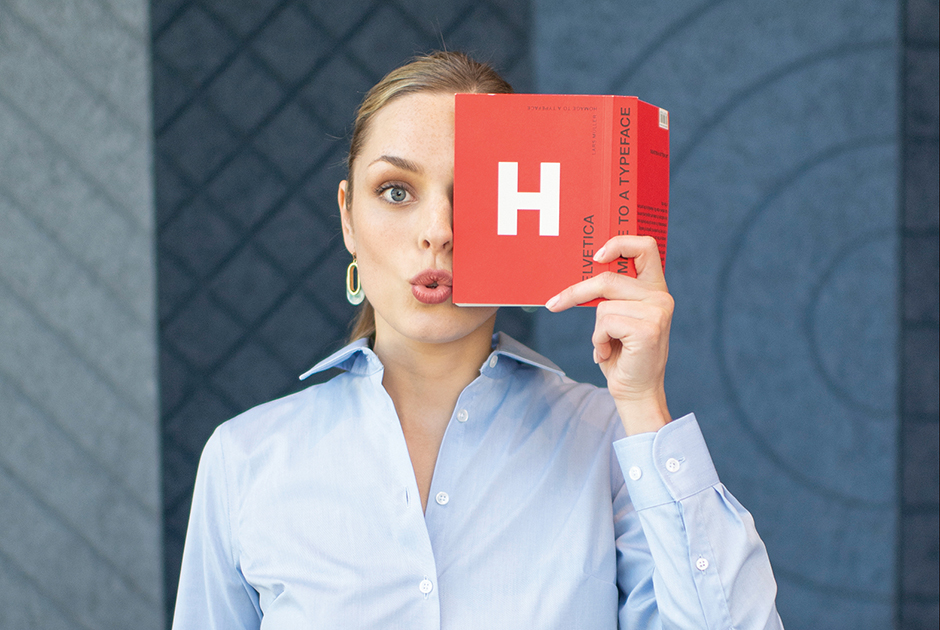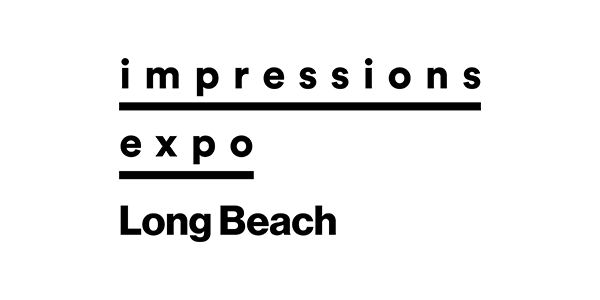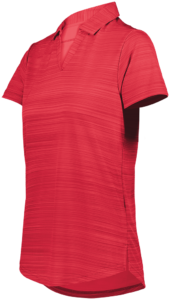
The Augusta Sportswear Pursuit Polo is versatile and comfortably designed for coaches, fans, professionals and more. Photos courtesy of Momentec Brands
To measure the popularity of the placket and woven categories in today’s promotional apparel market, we must consider where these styles fall behind the tried-and-true T-shirt. While a comfy T-shirt continues to lead the way as the largest selling category, in its wake are wovens, polos and placket designs. These styles continue to secure their respective niches through a marked resurgence in 2024 that is expected to continue in 2025.
Though they may account for smaller pieces of the proverbial pie, wovens and plackets are holding their own. An increase in a return-to-office environment and an uptick in versatility and comfort-driven details are big reasons why.
“T-shirts and polos are always in high demand, since they are versatile, comfort-driven wardrobe staples,” says Amy Carton, director of merchandising & brand management for SanMar. “With a focus on stretch and ease of movement, wovens are providing a fresh new look in the office, with all the benefits needed for an active workplace.”
Emily Quilter, product design director for Momentec Brands, seconds the staying power of the polo: “Polos continue to be very popular as a comfortable and versatile workwear option, particularly when done in performance fabrics,” Quilter says. “Performance polos also continue to be a go-to sideline option for athletic coaches and staff. This style is gaining in popularity with racquet sports, such as pickle ball, as well.”
The sales trend in the placket and woven categories as seen at the end of 2024 was expected to hold steady, even with an evolving shift of the workforce back to the office. However, the formal office dress we remember has been modified. Habits of the office dress code have changed as the need to “keep it formal” is no longer as necessary.
The work-from-home trend that resulted from the COVID-19 pandemic most definitely continues to leave a mark on the sales volumes of wovens for the office. That trend, coupled with an overall relaxed dress code in many office cultures, contributes to a steady sales projection.
“I would have to say the sales trend will meet in the middle,” says Jose Garcia Botello, founder and executive manager of YazbekUSA. “Bigger companies are asking their employees to go back into the office, but I don’t think it will mean a return to the same formal dress as before.”
The shakeout of four-plus years of a work-from-home mentality has also created a diversion from more formal dress codes to more casual attire—sometimes much more casual.
“The formal dress code has changed a lot over time,” Botello says. “Wovens were the go-to piece for corporate environments and organizations with very strict dress code guidelines. Nowadays, the trend is more relaxed and casual. T-shirts and jeans are more popular than ever and widely accepted in new corporate environments.”
The Untucking
The untucked trend in plackets and wovens remains popular, even in the corporate space. This trend has only strengthened over the past year and is sure to gain in popularity.
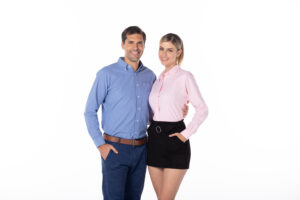
The traditional woven dress shirt never goes out of style, such as Yazbek’s Oxford. Photo courtesy of YazbekUSA
“Untucked shirts remain extremely popular,” says Eric Rubin, CEO of Blue Generation. “The trend took over the woven shirt market, and now with its more casual appearance, we still see tremendous strength in the category.”
To be sure, companies are paying attention to the untucked trend. For example, specialized brands in the retail market are laser-focused on this style, creating a garment that is longer than a regular cut to achieve the untucked look when worn out over the pants.
This is the perfect option for companies in the corporate space that still need their employees to portray a more corporate image. The look is polished, yet casual, checking all boxes. And it’s versatile.
“It looks great and can be dressed up or down,” Botello says. “It is versatile, and I’m positive the trend will translate into the blanks.”
An Opportunity?
Up-selling from T-shirts to a more structured style of shirt absolutely can be a viable way to increase margins, says Botello.
“In any supplier’s catalog, wovens represent a higher ticket,” he says. “The cost can range from three to five times the cost of a T-shirt. The margin is higher, and it helps.”
While up-selling is one way to boost margins, the budget of organizers from church groups and families holding reunions to corporations and companies holding events, also comes into play. Another consideration may be the overall objective for the shirts. A corporation, for instance, might consider a high-end, long-lasting gift for its employees versus a cost-effective T-shirt for a church’s 5k run or a family’s annual reunion.
“Although I would love to see customers step up to a polo shirt instead of a T-shirt, it is usually driven by a lower budget,” says Rubin. “T-shirts tend to be more casual than a polo or woven shirt.”
We know that wovens always have been popular in the hospitality and uniform markets. A woven shirt is simply dressier than a polo and typically projects a more upscale image. However, we also are seeing exciting innovations in woven shirts—both in fabric and styling—that give this category life outside of traditional corporate offices.
“Lightweight, stretch and UV protection fabrics in relaxed silhouettes transition to resort, travel and outdoor industries,” Carton says. “These characteristics make the pieces even more versatile.”
Wovens and plackets have longevity in the market that will remain sound, says Botello. “There is always a market for the style,” he says. “We have seen an increased demand for restaurant uniforms and retailers that prefer their collaborators to dress well. Wovens are here to stay, and the style is not going to disappear overnight. It has been around for years in the market, and there is always an opportunity to sell.”
Botello adds that, while woven and placket products are quite niched, specialized markets need access to those products to offer and sell.
Patterns, Fabrics and Fit
Heading in to 2025, we will see a continued presence of stretchy fabrics and loose feels.
“People love fabrics that stretch for comfort,” Rubin says. “There is no question in my mind that demand for stretch fabrics will continue to grow.”
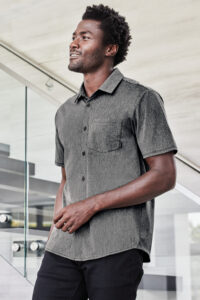
Add the casual OGIO knit shirt with mechanical stretch to your wardrobe. Photo courtesy of SanMar
Botello adds that the trend of oversized garments and softer stretchy fabrics is only just beginning. “Some brands have decided to address it by manufacturing bigger sizes that don’t look like you are wearing someone else’s shirt,” he says. “The loose fit has to do with comfort and ease of movement.”
A twist on tradition can be expected as well. For instance, polos tend to follow fashion trends, so we can expect to see a few different looks, says Quilter. These include modern, minimalist looks with visual fabric texture, smaller collars with upgraded construction to maintain shape and a return to a more classic, retro-preppy look that offers an on-trend, sporty design.
Rubin points to Blue Generation’s newly introduced “revolutionary polo,” which has a bonded knit collar mimicking a woven collar. “It is uniquely designed to transform a polo into a more polished, dressy look,” he says. “It is the perfect answer for those looking for the comfort of a polo shirt with the dressier look of a woven shirt. It can even be worn with a tie.”
Aesthetically, expect to see colors in various combinations and patterns, while fabrics will be even softer in 2025 as manufacturers strive to meet the demand of the end consumer. A nice-looking and long-lasting, comfortable piece will be complemented by a soft feel.
“Stripes, plaids and patterns are still a mainstay in the retail space for wovens,” says Carton. “For our customer, we are seeing growth in smaller, easy geo prints. These can easily work for individuals or groups, giving seasonal variety and a little pop of interest that can elevate classic styles.”
Patterns, in particular, pose a difference in the perception of the garment, says Botello. Smaller, finer designs can create a look that is more elegant to dress, whereas bigger patterns, such as squares, flowers and other mixed lines, can create a more casual look. Blue Generation offers a full line of tropical-printed camp shirts that are popular in the hotel and hospitality markets as well.
Polyester blends remain popular with plackets and wovens, with brands like Columbia and The North Face offering all-poly or all-cotton woven lines with breathable designs for outdoor activities—widely popular in the American market.
Fashion Forward
Fashion remains a driving a factor in the plackets and wovens space, fostering changes in all aspects of a garment. These shifts range from initial fabric choice, fit and silhouette to design detail decisions regard ing collar shape and size, and placket length.
“Performance and versatility are critical for today’s consumer, so fabrics with performance attributes are key,” Quilter says. “Consumers have come to expect performance attributes, such as wicking, stretch and softness, from their everyday apparel.”
The women’s space is seeing an increased demand for feminine woven shirting, says Hoffman. Expect to see styles with special details that give the customer a modern, polished office vibe. From a popover silhouette to subtle shirring and sleeve details, wovens will be the go-to option.
Rubin adds that sales volume is in the basics, no matter what the trending elements may dictate: “Customers always want to see what’s new,” he says, “but, although we offer 25 colors in many styles, black is the No. 1 selling color.”
The main takeaway? The woven shirt is not going away. “Fashion can add to the style, if we consider the oversized or untucked trends,” Botello says. “It is a piece that defines a polished, well-dressed, professional look, so it may be modified because our dressing habits are changing. However, it won’t disappear.”
Jennifer Morrell Todd is an award-winning writer who has written for a number of national consumer and trade publications. For more information or to comment on this article, email Jennifer at [email protected].

